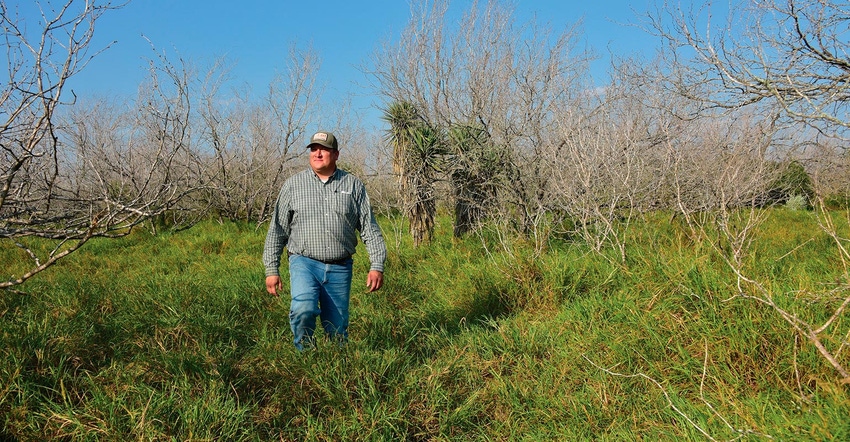Brush strategy benefits land, cattle, wildlife
LandVisor™ advanced brush management has helped the East Foundation convert mesquite monocultures to diverse, productive rangelands.
March 1, 2022

Sponsored Content
Managers for the East Foundation ranches love their South Texas native rangelands. But they also have previously cultivated pastures overtaken by mesquite thickets. So, they figured out a way to help both and get the most from an improvement budget.
The foundation, created in 2007 by the longtime-ranching East family, promotes land stewardship through ranching, science and education. Headquartered in San Antonio, the foundation uses its 217,000 acres across six South Texas ranches as a working lab.
For the most part, managers operate the ranches under the same constraints as other commercial enterprises. But they do have unusual access to scientists and technicians focused on the same lands.
By 2015, the management team concluded it was time to do something about the mesquite invasion. The team started on the Santa Rosa Ranch near Kingsville — a ranch with a reputation of not producing much more than feral hogs, fire ants and nilgai antelope.
The plan
The managers determined they could take a strategic approach to brush control that would benefit all the foundation ranchlands.
They would target pastures that in the 1970s and 1980s had been dozed or grubbed — often in strips — and reseeded with introduced grasses, such as bermudagrass and buffelgrass.
Since that mechanical work, regrowth mesquite and other woody brush had reinvaded. But these pastures still had remnants of the highly productive tame grasses. The managers reasoned they could reduce the brush and release more grass production than on native range.
They could use that production to increase stocking and, more important, provide a drought reserve. By improving these lands, they could decrease grazing pressure on the native rangelands.

They called Benny Martinez, the Range & Pasture Specialist for Corteva Agriscience in South Texas, to work through a plan with them.
From 2015 through 2018, the managers aerially sprayed every year on the Santa Rosa. They used
Sendero® herbicide at 28 ounces per acre. The herbicide controls mesquite but leaves most nontarget plants valuable for wildlife habitat.
Over a three-year period, the managers treated about 10,000 acres and averaged about 80% kill (of mesquite), resulting in a huge difference in potential forage production. At 85% mesquite canopy cover, forage production was around 20 to 30 pounds per acre. The pasture should produce 2,500 pounds per acre. Realizing that potential could offer an increase in stocking of 10% to 15%.
A plan enhanced
In 2019, the managers turned to a similar pasture on the San Antonio Viejo Ranch near Hebbronville. To better target the application and help with application timing, they enrolled in the new LandVisor™ advanced brush management from Corteva Agriscience.
The digital and imagery technology identifies soil types, key plant species, mesquite density and other factors. It estimates current and potential grass production to identify where spraying will offer the best return.
The managers had identified a rectangular block to spray. Within that block, LandVisor showed some areas where, because of mesquite density or soil quality, spraying wouldn’t yield much response.
So, they carved out those areas (not to spray) and reallocated those resources elsewhere. LandVisor validated some things the ranch managers knew, and it showed and helped identify areas where they could have the most impact.
The analysis, they estimate, took about 15 minutes with LandVisor. Using traditional methods, it would have taken three or four months.
More grazing, better habitat
The foundation sprayed 1,000 acres on the San Antonio Viejo Ranch in 2019. In May, before the application, grass production averaged 1,144 pounds per acre. In October 2020, about 17 months later, grass production averaged 5,359 pounds per acre.
Wildlife benefit, too. By opening the thicket, creating more of a mix of plants and leaving untreated mottes for edge, habitat is improved. Forb production went from 14 pounds per acre pretreatment to 53 pounds per acre post-treatment.
Grazable acres in a 1,000-acre pasture went from about 150 acres to now maybe 700. The foundation has plans to treat more acres, again using LandVisor to plan and time the application. It fits well with foundation objectives.
For more information on LandVisor advanced brush management, request a demo.
™ ® Trademarks of Corteva Agriscience and its affiliated companies. Sendero® is covered by U.S. Patent No. 10,412,964 and other pending U.S. patent applications, international patents, and pending international patent applications. Sendero is not registered for sale or use in all states. Contact your state pesticide regulatory agency to determine if a product is registered for sale or use in your state. Always read and follow label directions.
About the Author(s)
You May Also Like




.png?width=300&auto=webp&quality=80&disable=upscale)
